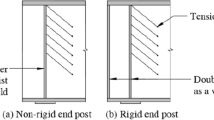Abstract
Theoretical predictions of the ultimate shear resistance of slender-plate girders are broadly based on either Cardiff theory or Höglund’s theory. Cardiff theory assumes an equilibrium stress field (tension field) in the girder, which satisfies the theoretical conditions for a lower-bound strength prediction, provided the material possesses sufficient ductility for the stress field to be developed. Previous investigators did not determine the limits of web panel aspect ratio (b/d) or its relation to inclination angle of membrane tensile yielding strength (IAMTYS), which are important parameters in Cardiff theory. This paper presents a theoretical analysis to identify the limits of b/d that can be applied to Cardiff theory and their relation with c/b, the ratio of the distance where the plastic hinges form in the flanges (c) to the panel width (b). This analysis is based on previously published experimental results of ninety six steel plate girders subjected to shear. We make recommendations regarding (1) the optimum limits of panel aspect ratio for a given IAMTYS, and (2) the range of c/b values that can be used to predict the ultimate shear resistance using Cardiff theory.
Similar content being viewed by others
References
Au, A., Lam, C., and Tharmabala, B. (2009). “Experimental investigation of the ultimate shear resistance of end web panels in steel girder bridges.” Canadian Journal of Civil Engineering, 36(2), pp. 267–279.
Bradford, M. A. (1996). “Improved shear strength of webs designed in accordance with the LRFD specification.” Engineering Journal, 33(3), pp. 95–100.
British Standards Institution. (2001). BS 5950-1: Structural use of steelwork in building. Code of practice for design. Rolled and welded sections, London, UK.
Broujerdian, V., Mahyar, P., and Ghadami, A. (2015). “Effect of curvature and aspect ratio on shear resistance of unstiffened plates.” Journal of Constructional Steel Research, 112(9), pp. 263–270.
Darehshouri, S. F., Shanmugam, N. E., and Osman, S. A. (2013). “An analytical method for ultimate shear strength of composite plate girders with web openings.” Engineering Structures, 56(11), pp. 610–620.
Davies, A. W. and Griffith, D. S. C. (1999). “Shear Strength of steel plate girder.” Proceedings of the Institution of Civil Engineers: Structures and Buildings, 134(2), pp. 147–157.
European Committee for Standardization. (2006). Eurocode 3-BS EN 1993-1-5: Design of steel structures. Plated structural elements, Brussels, Belgium.
Fang, C., Lam, A. C. C., and Yam, M. C. H. (2013). “Influence of shear lag on ultimate tensile capacity of angles and tees.” Journal of Constructional Steel Research, 84(5), pp. 49–61.
Lee, S. C. and Yoo, C. H. (1998), “Strength of plate girder web panels under pure shear.” Journal of Structural Engineering ASCE, 124(2), pp. 184–194.
Lee, S. C., Davidson, J. S., and Yoo, C. H. (1996). “Shear buckling coefficients of plate girder web panels.” Computers and Structures, 59(5), pp. 789–795.
Roberts, T. M. and Shahabian, F. (2001). “Ultimate resistance of slender web panels to combined bending shear and patch loading.” Journal of Constructional Steel Research, 57(7), pp. 779–790.
Sulyok, M. and Galambos, T. V. (1996). “Evaluation of web buckling test results on welded beams and plate girders subjected to shear.” Engineering Structures, 18(6), pp. 459–464.
Timoshenko, S. P. and Gere, J. M. (1985). Theory of Elastic Stability, 2nd ed., McGraw-Hill, New York, N.Y., USA.
Author information
Authors and Affiliations
Corresponding author
Rights and permissions
About this article
Cite this article
ELamary, A.S. Cardiff theory: Web panel aspect ratio limits and their relation with inclination angle of membrane tensile yield strength. Int J Steel Struct 16, 799–806 (2016). https://doi.org/10.1007/s13296-015-0189-7
Received:
Accepted:
Published:
Issue Date:
DOI: https://doi.org/10.1007/s13296-015-0189-7




